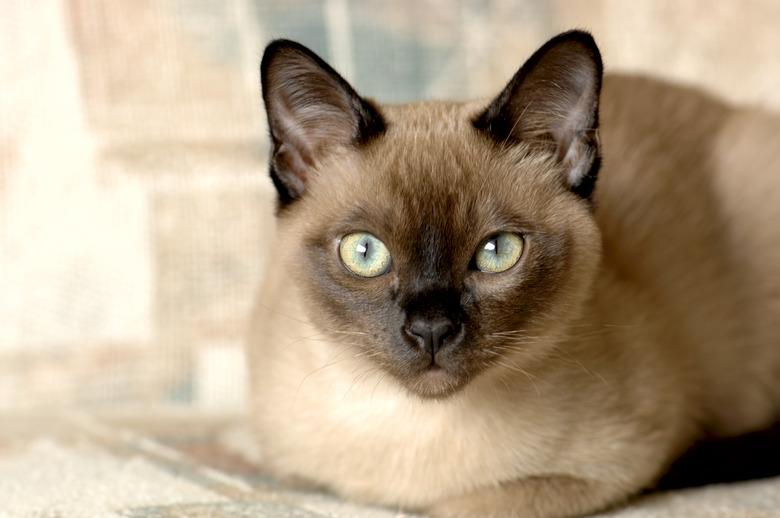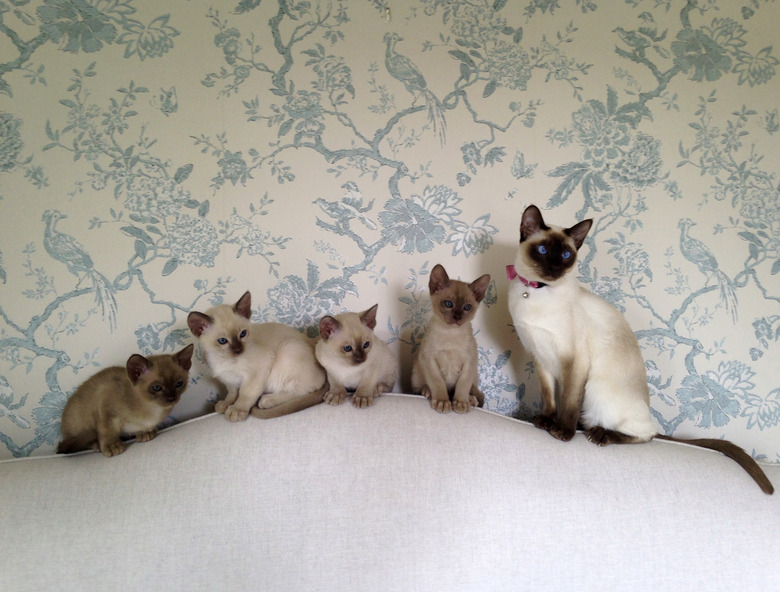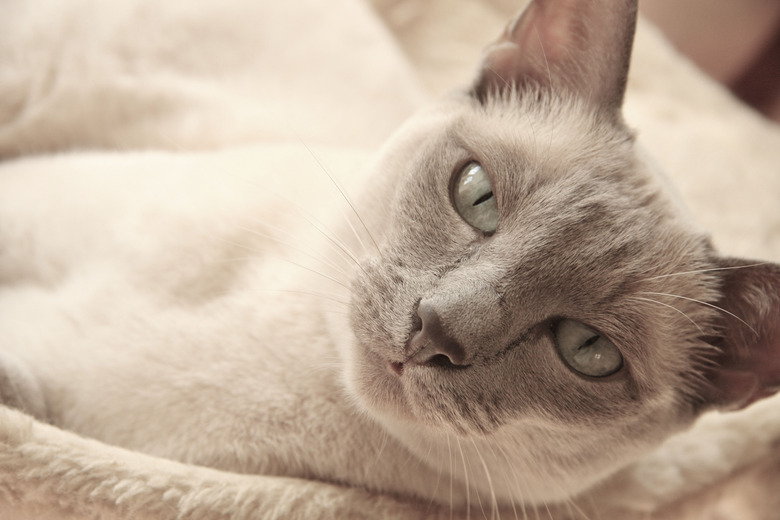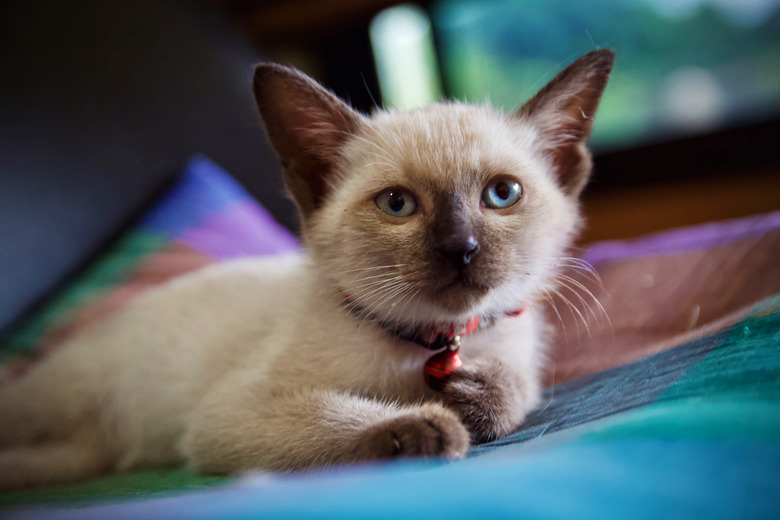Tonkinese Cat Breed Characteristics
Tonkinese cat quick facts
Tonkinese cat quick facts
Length: 12 – 15 inches
Weight: Females: 6 – 8 pounds, males: 8 – 12 pounds
Lifespan: 12 – 16 years
Coat length: Short
Coloring: Blue, champagne, natural, and platinum. Coat patterns include a pointed coat with blue eyes, a mink coat with aqua eyes, or a solid coat with yellow-green eyes.
Grooming needs: Low
Friendliness: Breed alone is not an accurate predictor of individual cats' personalities. However, Tonkinese cats are generally regarded as sweet and loyal
The Tonkinese cat is a medium-sized cat with a beautiful coat and almond-shaped eyes. They just might be the ideal combination of a playful lap cat. Plus if you already have other pets or children in the home, the Tonkinese is sure to enjoy having playmates around. Tonkinese cats have short coats that require minimal grooming. Consider the breed's personality and care requirements before committing to bringing home a Tonkinese kitten.
Tonkinese cat history
Tonkinese cat history
The Tonkinese breed was developed by crossing Siamese and Burmese cats. In 1930, the first Tonkinese cat was brought to the United States by Dr. Joseph Thompson. She had a mink-colored coat and was named Wong Mau. She was one of the cats used to develop the brown sepia coloring in the Burmese breed.
In the 1960s, two cat breeders started to develop the Tonkinese cat breed. Margaret Conroy from Canada bred her Burmese female to a male Siamese cat. The kittens had tan coats and a beautiful aqua eye color. Margaret continued developing the breed with that coloring. The other breeder, Jane Barletta, was working to create a cat breed with characteristics that were a blend of the parent Siamese and Burmese breeds.
Together, the two breeders worked to develop the breed that is now recognized as the Tonkinese. The breed is recognized and has championship status in many organizations including the International Cat Association (TICA) and the Cat Fanciers' Association (CFA).
Tonkinese cat personality
Tonkinese cat personality
Tonkinese cats are sweet and loyal. They are very sociable and get along with both human and animal members of the family. They prefer to have company around them. So if you spend a lot of time out of the house and don't have any other pets, this may not be the best breed for you.
The Tonk will gladly spend their time cuddling and being a lap cats but they are also athletic and playful. They aren't generally the type to cause trouble when they are bored. Though this intelligent cat enjoys exploring, jumping up to high perches, and even playing with interactive toys. They will joyfully run and play, especially if you have another cat or a dog in the house.
The Tonkinese cat can be quite vocal at times. While they don't tend to constantly talk, they will likely respond with some meows when you speak to them.
Tonkinese cat lifespan and health issues
Tonkinese cat lifespan and health issues
A healthy Tonkinese cat can live 12 to 16 years or more. They are generally quite healthy, but there are some health conditions that affect the breed. Some conditions to watch out for include:
- feline lower urinary tract disease: a condition that affects the cat's bladder or urethra.
- inflammatory bowel disease: A condition that causes inflammation and irritation in the gastrointestinal tract.
- amyloidosis: A condition that causes the build-up of amyloid proteins in the organs, often the kidneys.
The breed is also more prone to developing periodontal disease and gingivitis. Make sure to watch for symptoms of these or any other health problems. Take your cat to the veterinarian for their regular checkups and vaccinations.
Tonkinese cat grooming and care
Tonkinese cat grooming and care
Tonkinese cats have a short coat that is easy to groom and care for. Weekly brushing is all they need to maintain a healthy coat. Check and trim the cat's nails regularly and clean the ears as needed.
Since the breed is prone to developing gingivitis, it is important to brush the cat's teeth regularly. Use toothpaste that is designed for pets and discuss dental cleaning with your veterinarian.
Feed the cat a high-quality commercial cat food as recommended by your veterinarian. It is important to note that obesity can be a problem, so avoid free feeding the cat. If the cat starts to become overweight, spend more time playing to increase their activity level. Speak with your veterinarian to determine the best type and amount of food to feed the cat. Avoid giving the cat too many treats. If you offer treats during a play or training session, be sure to decrease the amount of the cat's regular meal.
Welcoming a new cat into your home
Welcoming a new cat into your home
Take some time to cat-proof your home and get all of the things you will need for your new kitten. Cat proofing includes:
- removing poisonous houseplants from the home
- securing cleaning supplies and other toxic items where the cat can't get to them
- keeping the counters clear of any potentially harmful foods such as chocolate, garlic, and certain spices
- putting away any breakable items and keepsakes
This breed enjoys jumping up to high perches, so make sure you have a cat tree and shelves where they can explore. Make sure you also have a scratching post so that the cat can satisfy their natural instinct to scratch. Set up food and water dishes and select a location for the litter box that is quiet and safe while still being easy for the cat to access.
When you first bring your new cat home, keep them in a single room. This allows them to explore and get used to their new surroundings. It also gives you an opportunity to safely introduce any other pets in the household.
Tonkinese cats don't like being alone for long, so spend plenty of time with your new cat. Build a loving and trusting relationship by using plenty of positive reinforcement and allow the cat to come to you when they are ready. Don't try to make the cat sit in your lap or be petted.
When your cat is comfortable, you can open up the door and allow them access to more of the home. With a bit of patience and love, this affectionate cat will soon be cuddling with you and following you around the house.



